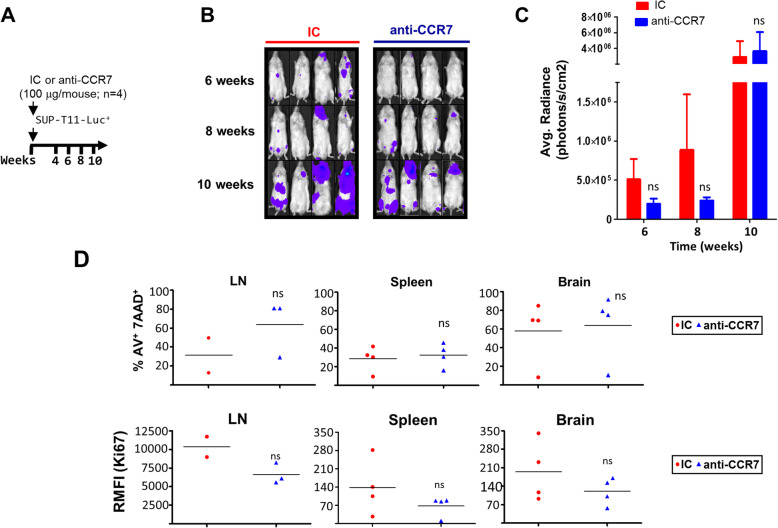Fig. 5.
Anti-CCR7 Fab-mediated MOA moderately delay tumor onset and inhibit tumor burden in the SUP-T11-luc+ disseminated T-PLL models. a Schematic representation of development and treatment schedule in model 1. This preventive model was developed by treating irradiated NSG deficient mice with a single dose of 5 mg/kg (~ 100 μg/mouse) of either anti-CCR7 (n = 4) or the respective IC (n = 4) 2 h before the intravenous inoculation of 5 × 105 SUP-T11-luc+ cells (arrow indicates antibody administration). b-c Anti-CCR7 mAb preventive therapy tends to reduce tumor burden and growth. Tumor burden follow-up was determined by whole body (back and front) bioluminescent analyses of each mouse on weeks 4, 6, 8, and 10. To simplify, only front images are shown (b). Quantification of luciferase activity is shown as mean ± SEM (c). d Blocking CCR7 seems to induce cell death in the LN and to reduce the proliferative phenotype in SUP-T11-luc+ cells migrated to the LN, spleen and brain. At sacrifice, one million cells from LN, spleen, and brain were harvested for flow cytometry analyses. Cells were incubated with anti-human-CD5 and anti-hCD45 antibodies, and with either Annexin-V/7-AAD, to quantitatively determine the proportion of non-viable cells, or with fluorochrome-conjugated antibody directed against the proliferative protein Ki67 in order to determine expression levels of this marker. The percentage of SUP-T11-luc+ dead cells and the median intensity of fluorescence of Ki67 relative to the IC (RMFI, arbitrary units) are shown. Each symbol represents one individual mouse. Horizontal bars represent the mean. ns, not significant

